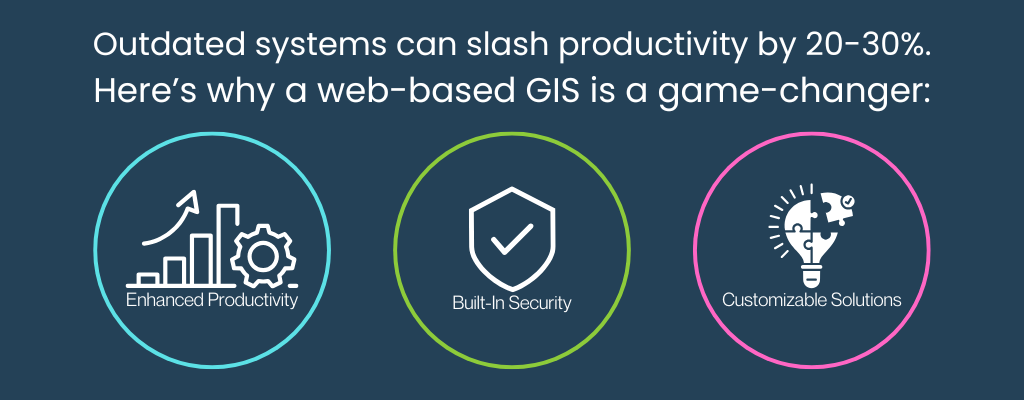Imagine this: A city planner scrambles for three days to fix crashed servers instead of completing vital evacuation route maps. This frustrating scenario is all too common among GIS professionals, who often find themselves spending more time wrestling with technical issues than focusing on essential geospatial work. It’s a stark reminder that outdated systems and technical limitations can hold back even the most skilled teams.
Enter web-based GIS – a transformative approach that shifts the focus back to what truly matters: mapping, analysis, and serving your community.
Core Benefits of Web-Based GIS
Web-based GIS eliminates many of the pain points that come with traditional desktop GIS. Teams can finally dedicate their time and energy to geospatial work rather than IT troubleshooting. Here’s why it’s a game-changer:
- Enhanced Productivity: No more server crashes, backup headaches, or time-consuming maintenance tasks.
- Built-In Security: Modern platforms prioritize data protection, allowing your team to work without fear of breaches.
- Customizable Solutions: Flexible features adapt to your organization’s unique workflows and goals, eliminating the rigidity of one-size-fits-all systems.

Breaking Through Traditional Limits
The old-school desktop GIS approach forces organizations into rigid frameworks that rarely fit their specific needs. McKinsey & Company research underscores the impact of inefficiency, showing that outdated systems can slash productivity by 20-30%. When dealing with critical geospatial data, that’s time you simply can’t afford to waste.
Web-based GIS breaks free of these limitations, offering scalable, flexible solutions that empower teams to innovate without being held back by hardware or software constraints.
Real-World Impacts on Teams
The switch to web-based GIS has led to measurable improvements across industries. Forbes research highlights how cloud-based technologies drive efficiency and flexibility for organizations of all sizes. For GIS teams, these benefits are particularly powerful:
- Real-Time Collaboration: Team members can work together on projects, no matter where they’re located.
- Automated Updates and Backups: Forget manual updates or worrying about losing work due to system failures.
- Seamless Scaling: Web-based GIS grows with your organization, removing the need for constant hardware upgrades.
McKinsey & Company also notes how modern technology streamlines workflows, making it easier to meet deadlines and manage resources effectively. For GIS professionals, this translates to less time fighting outdated systems and more time delivering actionable insights.
Built-In Security for Peace of Mind
In an era where data breaches are a constant threat, web-based GIS platforms integrate advanced security measures to protect sensitive geospatial data. Features like encrypted connections, role-based access, and automated compliance updates ensure your team can work confidently without interruptions.
The Path Forward
Transitioning to web-based GIS isn’t just an upgrade – it’s a strategic shift that empowers organizations to focus on what matters most. By moving away from outdated systems, GIS professionals can:
- Save time on IT maintenance.
- Deliver faster, more accurate mapping and analysis.
- Build stronger, more resilient communities.
The future of GIS lies in smarter tools that adapt to your needs, freeing your team to create meaningful solutions. With web-based GIS, you’re no longer held back by technology – instead, you’re leveraging it to move forward.
Ready to leave behind the frustration of traditional systems and unlock the full potential of your geospatial work? The time to embrace web-based GIS is now. Want a free demo with your data? Contact us!
Sources:
Forbes Business Council. (2022, October 27). The future of cloud computing. Forbes. Retrieved January 19, 2025, from https://www.forbes.com/councils/forbesbusinesscouncil/2022/10/27/the-future-of-cloud-computing/
McKinsey & Company. (n.d.). The productivity imperative: How organizations can do more with less. Retrieved January 19, 2025, from https://www.mckinsey.com/featured-insights/employment-and-growth/the-productivity-imperative




